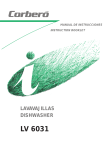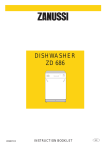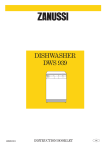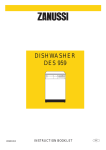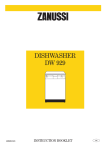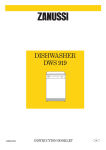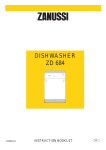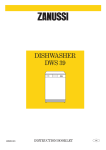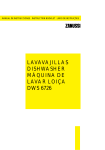Download CORBERO LV 6042 Instruction manual
Transcript
MANUAL DE INSTRUCCIONES INSTRUCTION BOOKLET LAVAVAJILLAS DISHWASHER LV 6042 Attention The appliance which you have just bought is supplied not only with this instruction manual, but also with a Warranty Card Certificate, on the back of which are written the relative conditions. Please fill in the necessary details on the Card Certificate and send it to the Corberó Centre relative to the area in which the appliance is to be installed, within twenty days of the date of purchase. (See list of Corberó network centres). We congratulate you on your choice. Carefully read this instruction manual and follow attentively the recommendations it provides, and thus benefit from years of excellent service. The appliance which you have just purchased has been very accurately controlled throughout the entire manufacturing process. Nevertheless, should any problem arise during usage, whether it be during the warranty period, or when such period has expired, please directly contact your nearest Corberó Service Centre. The address and telephone number of said Centre can be easily found in the enclosed List or by looking in the telephone directory, under Corberó. Our Corberó Service Network is at your complete disposal, to serve you with maximum speed and efficiency, all you have to do is call. The products In order to obtain a good wash, it is necessary to use detergents specially designed for dishwashers. To ensure that your dishwasher functions perfectly, Corberó recommends using Calgonit System, a unique and complete product, tested by millions of householders. Calgonit System includes Calgonit detergent, rinse aid, salt, machine detergent and Citro-Fresh. It is able to fulfil the main requirements for clearing both the crockery and the machine itself. 23 GAR01en Contents For the user For the installer Important safety information 25 Description of the appliance 26 The control panel 26 Before use Setting the water softener Rinse aid 27 27 29 Using your appliance Loading your appliance Adjusting the height of the upper basket Use of detergent 30 30 31 32 Hints and tips 33 Washing programmes 34 Operating sequence 35 Maintenance and cleaning Internal cleaning Cleaning the central filter Cleaning the large filter External cleaning Prolonged periods of non-operation Frost precautions Moving the machine 36 36 36 36 37 37 37 37 Something not working Service and spare parts 38 39 Hints for test centres Technical specifications 40 40 Installation instructions Water supply connections Water outlet connection Electrical connection 41 41 42 42 Adjusting the worktop Fitting under a counter Levelling Fitting a decor panel on the door 43 43 43 43 Guide to use the instruction book The following symbols will be found in the text to guide you throughout the instructions: Safety instructions 1. 2. 3. Step by step Hints and tips Environmental information 24 IND12en Important safety information It is most important that this instruction book should be retained with the appliance for future reference. Should the appliance be sold or transferred to another owner, or should you move house and leave the appliance, always ensure that the book is left with the appliance in order that the new owner can get to know the functioning of the appliance and the relevant safety information. This information has been provided in the interest of your safety. You MUST read it carefully before installing or using the appliance. Installation ● This appliance is heavy. Care should be taken when moving it. ● It is dangerous to alter the specifications or attempt to modify this product in any way. ● Care must be taken to ensure that the appliance does not stand on the electrical supply cable. ● Any electrical work required to install this appliance should be carried out by a qualified electrician or competent person. ● Do not sit or stand on the open door. ● Isolate the appliance from the power supply and turn off the water supply after use. ● Care should be taken when cleaning the bottom door seal and hinge area as any exposed metal edges may cut if care is not taken. ● This product should be serviced by an authorised Service engineer, and only genuine spare parts should be used. ● Under no circumstances should you attempt to repair the machine yourself. Repairs carried out by inexperienced persons may cause injury or serious malfunctioning. Contact your local Service Force Centre. Always insist on genuine spare parts. Any plumbing work required to install this appliance should be carried out by a qualified plumber or competent person. Child Safety ● ● Conservation This appliance is designed to be operated by adults. Children should not be allowed to tamper with the controls or play with the product. ● Keep all packaging well away from children. ● Keep all detergents in a safe place out of children's reach. In the interest of the environment: ● Materials marked with the symbol recyclable. ● Check with your local Council or Environmental Health Office to see if there are facilities in your area for re-cycling this appliance. ● When the appliance is to be scrapped, cut off the power supply cable and make the door closing device unusable to prevent young children from being trapped inside. ● Help to keep your country tidy - use authorised disposal sites for your old appliance. During Use ● Items that are contaminated by petrol, paint, steel or iron debris, corrosive, acidic or alkaline chemicals must not be washed in this dishwasher. ● Under no circumstances should you open the door whilst the appliance is in operation. Always turn off the appliance before opening the door. ● Only use detergent specifically designed for use in dishwashers. ● Long blades knives stored in an upright position are a potential hazard. ● Long and/or sharp items of cutlery such as carving knives must be positioned horizontally in the upper basket. ● When finishing loading or unloading close the door, as an open door can be a hazard. 25 are AVV01en Description of the appliance 1. Water hardness adjustment 2. Levelling spacers 3. Upper basket stop 14 1 4. Salt container 2 5. Large filter 3 6. Detergent dispenser 7. Control panel 8. Rating plate 9. Rinse aid dispenser 13 12 11 4 10 5 10. Central filter 11. Lower spray arm 6 9 12. Upper spray arm 13. Upper basket 8 14. Worktop 7 IN68 The control panel 1 23 4 5 1. On/Off indicator light 6 7 8 8. Programme sequence indicator As the programme progresses, the programme selector dial turns, to show the phase in the wash programme the appliance has reached. 2. On/Off pushbutton 3. Pushbutton "50" 4. Programme guide Prewash /Rinse and hold 5. Door handle Wash 6. Programme marker Cold rinse 7. Programme selector dial Hot rinse Drying 26 APP16en Before use Before using your dishwasher for the first time: 1. ensure that the electrical and water connections comply with the installation instructions 2. remove all packaging from inside the appliance 3. set the water softener 4. pour 1 litre of water inside the salt container and then fill with salt 5. fill the rinse aid dispenser. Water hardness Setting the water softener The dishwasher is equipped with a water softener designed to remove minerals and salts from the water supply, which would have a detrimental or adverse effect on the operation of the appliance. The higher the content of these salts, the harder your water is. Water hardness is measured in equivalent scales, German, French degrees and PPM (parts per Million). The softener should be adjusted according to the hardness of the water in your area. Your local Water Authority can advise you on the hardness of the water in your area. The dishwasher is factory set at level 2. If this level is not suitable for your area the softener should be adjusted. German degrees (°dH) French degrees (°TH) PPM (Parts per Million) Level Use of salt 0-4 0-7 0 - 80 0 NO 5 - 11 8 - 25 81 - 200 1 YES 12 - 22 26 - 40 201 - 400 2 YES 23 - 34 41 - 60 401 - 600 3 YES 35 - 50 61 - 90 601 - 900 4 YES 51 - 67 91 - 120 901 - 1200 5 YES If your water is level 0 it is already soft and therefore there is no need to use salt. In this case adjust the water softener on level 1 without using salt. To adjust the water softener 3 4 With a screwdriver turn the selector on the upper front corner of the machine until the level required corresponds with the marker. 5 2 2 1 AA05 27 PDU06en Filling with salt Only use salt specifically designed for use in dishwashers. All other types of salt not specifically designed for use in dishwasher, especially table salt, will damage the water softener. Only fill with salt just before starting one of the complete washing programmes (not the Rinse and Hold programme). This will prevent any grains of salt or salty water, which may have been spilled, remaining on the bottom of the machine for any period of time, which may cause corrosion. To fill: 1. To fill with salt, unscrew the cap of the salt container. LE SA LT SA LZ SA L SE 2. Pour 1 litre of water inside the container (this is necessary only before filling with salt for the first time). 3. Then using the funnel provided, pour in the salt until the container is full. Do not worry if water over flows from the unit when filling with salt, this is quite normal. 4. Replace the cap making sure that there is no trace of salt on the screw thread or on the gasket. SR06 5. Screw on the cap tightly. The salt container will require topping up periodically. The salt cap has a refill indicator window in the centre. A green float is clearly visible when there is salt inside the container, and almost disappears when the salt has finished reminding you to add salt. SR11 28 SAL02en Rinse aid Rinse aid is automatically added during the last rinse, ensuring thorough rinsing, spot and streak free drying. The dispenser, which is positioned inside the door, holds about 110 ml of rinse aid, which is sufficient for 16 - 40 dishwashing programmes, depending upon the dosage setting. Filling with rinse aid 1. Open the container by turning the lid (A) anticlockwise. 2. Add the rinse aid until the container is completely full. The indicator (B) will be completely dark. A 3. Top up the rinse aid when the indicator (B) because clear. BR01 Ensure that the lid is closed after every refill. Do not put liquid detergent in the rinse aid department. Clean up any rinse aid spilt during filling with an absorbent cloth to avoid excess foaming during the next wash. x 6 5 4 3 2 1 m a B Adjusting the dose BR03 C x 6 5 4 3 2 1 m a According to the finish and drying results obtained, adjust the dose of rinse aid by means of the 6 position selector (C) (position 1 minimum dosage, position 6 maximum dosage). Start from position 3. Gradually increase the dose if there are drops of water or lime spots on the dishes after washing. Reduce it if there are sticky whitish streaks on the dishes. BR02 29 BRI01en Using your appliance Loading your appliance Before placing dishes in the machine, remove any scraps of food, to avoid clogging the filters and consequently reducing the performance. Do not load very small items which can fall through the baskets. The lower basket The lower basket is designed to take saucepans, lids, plates, salad bowls, cutlery etc. Serving dishes and large lids should be arranged around the edge of the basket, ensuring that the upper spray arm can turn freely. UI05 The cutlery basket UI19 Long bladed knives stored in an upright position are a potential hazard. Long and/or sharp items of cutlery such as carving knives must be positioned horizontally in the upper basket. Take care when loading or unloading sharp items such as knives. Cutlery should be placed in the removable cutlery basket with the handles facing downwards. If the handles protrude from the bottom of the basket, obstructing the lower spray arm, load the cutlery with the handles facing upwards. Mix spoons with other cutlery to prevent them from sticking together. Arrange spoons, dessert spoons, knives and other small items of cutlery in the racks on both sides of the cutlery basket. UI03 30 CES12en The upper basket The upper basket is designed for plates (dessert plates, saucers, dinner plates of up to 24 cm in diameter), salad bowls, cups and glasses. Long-stem glasses can be suspended from the prongs of the cup racks. Arrange items on and underneath the fold-down cup racks so that water can reach all surfaces. For taller items, the cup racks can be folded upwards. Light items (plastic bowls etc.) should be loaded in the upper basket and arranged so they do not move. US29 Before closing the door, ensure that the spray arms can rotate freely. Adjusting the height of the upper basket A If washing very large plates (over 27 cm and up to 31 cm in diameter) you can load them in the lower basket after moving the upper basket to the higher position. In order to carry out the following operations easily we recommend you to load the upper basket to the higher position. B C To move to the higher position proceed as follows: 1. Pull out the basket until it stops. 2. Carefully lift the basket upwards (position A). 3. Push slightly downwards (position B). RC07 When the top basket is in the higher position it will only take plates up to 20 cm in diameter and you will not be able to use the raised cup racks. To lower the basket to the original position 1. Carefully lift the basket upwards (position A), then push downwards (position C). After loading your machine always close the door, as an open door can be a hazard. 31 CES10en Use of detergent Only use detergents specifically designed for use in dishwashers. Min = 15 g Max = 30 g D If using powder detergents proceed as follows: 1. Open the dispenser lid by pulling the catch (D). 2. Add the detergent according to the recommendations in the programme chart. As all detergents are not the same, you should also consult the instructions on the packet. 3. Always close the lid. 4. If the programme has a prewash add the required detergent over the lid of the dispenser. M M IN AX DE17 If using detergent in tablets proceed as follows: 1. For all programmes; place 1 tablet inside the detergent dispenser. 2. Always close the lid. 3. For all programmes with prewash; place a portion of a further tablet on the lid of the detergent dispenser. DE02 Insufficient quantities of detergent will produce poor washing results, whereas an excessive amount of detergent will not improve washing results and is also wasteful. Using no more than the correct amount also contributes to reducing pollution. Compact detergents with enzymes In these compact powders the environmently unfriendly components have been replaced by natural enzymes and other more biodegradable substances. The enzymes deploy their full dirt dissolving power at a temperature as low as 50°C. By choosing the "50°C" programmes you can therefore achieve the same cleaning results that would otherwise be achievable only with 65°C programmes and conventional detergents. These new compact powders are generally phosphate-free. As phosphates have water softening properties, we suggest you add salt to the salt container even if the hardness of your water is as low as 4°dH (7°TH). This will avoid lime deposits on crockery and the inner tub. 32 DET04en Hints and tips To save energy Items not suitable for dishwashers Place dishes in the machine immediately after every meal and wait until the dishwasher is full before washing. If necessary run the Rinse and Hold programme (see "Washing Programmes" chart) so that any food scraps do not become caked on the dishes while you are waiting to run the complete wash programme. Do not prewash dishes under running water. Select an economic or a quick programme when dishes are not very soiled, following the instructions given in the "Washing programmes" chart. The following items should not be washed in the dishwasher (unless they are sold as dishwasher proof): - Cutlery with wooden or horn handles or glued parts - bronze cutlery - saucepans with wooden handles - aluminium ware - crystal ware - leaded glass - plastic items - antique or fine decorated china For best washing and drying results Before loading remove all scraps of food and soak very heavily soiled pots and pans. Arrange saucepans, cups and glasses etc. upsidedown. Tilt items with convex or concave surfaces so that the water drains off easily. Avoid contact between the dishes as far as possible. Wait a few minutes before removing the dishes; in this way they will be cooler and the drying will be improved. Empty the lower basket first and then the upper one; this will avoid water dripping from the upper basket onto the dishes in the lower one. You will improve drying results by leaving the dishwasher door ajar for at least 15-30 minutes as soon as the programme finishes. Certain types of decoration can discolour when washed in a dishwasher. Crystal-ware and plastic objects, if not guaranteed dishwasher proof should be washed by hand. Certain types of glass can also become opaque after being washed several times in a dishwasher. A chemical reaction can occur between silver cutlery and stainless steel cutlery. As a precaution, do not wash together. Iron and cast iron objects can rust and stain other items. Aluminium tends to go black, copper, pewter and brass tend to stain. If in doubt check with manufacturer of the item. When buying new dishes, ensure that they are dishwasher proof. 33 CON05en Washing programmes Programme Degree of soil and type of load NORMAL 65°C WITH PREWASH Normal soil. Crockery and cutlery ECONOMY 50°C NO PREWASH * QUICK 50°C RINSE AND HOLD Starting position Required of the programme pushbuttons selector in the dispenser on the dispenser lid Cycle description 5g Cold prewash Main wash up to 65°C 2 cold rinses 1 hot rinse Hot air drying 25 g / Main wash up to 50°C 2 cold rinses 1 hot rinse Hot air drying 50 + On/Off 25 g / Main wash up to 50°C 1 cold rinse 1 hot rinse On/Off / / 1 cold rinse, (to avoid food scraps from sticking together). A On/Off Light soil. Crockery and cutlery B 50 + On/Off Light soil. Crockery and party crockery C D Any. Partial load (to be completed later in the day). Recommended quantity of detergent 25 g * This is a special programme for quick washing a full load of lightly soiled dishes, glasses and crockery (except pots) so that you may re-use them promptly. 34 PRO12en Operating sequence 1. Check the filters 8. Ensure they are clean and properly positioned (see "Maintenance and cleaning"). 2. Check that there is rinse aid and salt 3. Load the dishes Start the programme Depress the On/Off pushbutton. The On/Off indicator light will come on and the machine will start. If you wish to interrupt the washing programme at any time press this button again. 9. Remove any scraps of food. Pull the lower basket out and arrange the saucepans, plates and cutlery in it. Pull the upper basket out and arrange the plates, saucers, glasses and cups etc. in it. Slide the baskets back into the machine. At the end of the washing programme At the end of the programme the dishwasher will automatically stop. The On/Off indicator light remains on until the On/Off pushbutton is depressed. 10. Switch off the dishwasher 4. Ensure that the spray arms can rotate freely. 5. Measure out detergent Switch off the dishwasher by pressing the On/Off pushbutton and open the door. When the washing programme has finished, it is recommended that the dishwasher is unplugged and the water tap turned off. Add the required amount of detergent into the dispenser according to the "Washing programmes" chart. Close the detergent dispenser lid. 6. Close the dishwasher door 7. Set the programme In general it is not advisable to open the door while the machine is working;if the door is opened however, a safety device ensures that the machine stops. Turn the programme selector dial clockwise until the letter of the programme you wish to select corresponds with the programme marker on the control panel. Caution Do not open the door during the hot phase: this may cause hot water escape. If necessary select the temperature of the main wash according to the instructions in the "Washing programmes" chart (see "Required pushbuttons"). Care must be taken if the door is opened during the hot phase or immediately after a programme has finished, as steam may escape. 35 SEQ12en Maintenance and cleaning Internal cleaning Ensure that the seals around the door, the detergent and rinse aid dispensers are cleaned regularly with a damp cloth. We recommend every 3 months to run a 65°C wash programme without dishes using detergen. Cleaning the central filter (After each wash) Scraps of food may accumulate in the drain filter (A) and should be removed by rinsing the filter under running water. To remove the drain filter - simply pull it out by the handle. A Once cleaned, refit the filter by pushing it back to its original position until it engages. MA04 Cleaning the large filter (Every month) If necessary clean the large filter (B) on both sides under running water, using a brush. To remove the large filter 1. Remove the spray arm by pulling it upwards on one side. 2. Turn the column (C) anticlockwise by 90° and then slide out the filter. 3. Once cleaned refit it following the above instructions in reverse order. 4. Ensure the filter is in its original position, the handle of the drain filter should be pointing towards the front of the appliance. 90° B C MA05 The dishwasher must not be used without filters. Incorrect repositioning and fitting of the filters will produce poor washing results. Cleaning the filters is vital to ensure correct operation of the machine. 36 MAN01en External cleaning Clean the external surfaces of the machine and control panel with a damp soft cloth. If necessary use only neutral detergents. Never use abrasive products, scouring pads or solvent (acetone, trichloroethylene etc....). Prolonged periods of non-operation If you are not using the machine for any period of time you are advised to: 1. Unplug the appliance and then turn off the water. 2. Fill the rinse aid dispenser. 3. Leave the door ajar to prevent the formation of any unpleasant smells. 4. Leave the inside of the machine clean. Frost precautions Avoid placing the machine in a location where the temperature is below 0°C. If this is unavoidable, empty the machine, close the appliance door, disconnect the water inlet pipe and empty it. Moving the machine If you have to move the machine (moving house etc....): 1. Unplug it. 2. Turn the water tap off. 3. Remove the water inlet and discharge hoses. 4. Pull the machine out together with the hoses. Avoid over tilting the machine during transport. 37 MAN03en Something not working Certain problems are due to lack of simple maintenance or oversights, which can be solved easily without calling out an engineer. Before contacting your local Service Force Centre, please carry out the checks listed below. Symptom The machine will not start Solution ● ● ● The machine does not fill with water ● ● ● ● The door has not been properly closed. The plug is not properly inserted in the power socket. There is no current at the socket. Ensure the water tap is open. Ensure the mains water supply has not been cut off. The inlet hose may be squashed or bent. Reposition the hose. The inlet hose may be blocked. Switch off the water supply and clean the filter. The filters are blocked ● Clean the filters (refer to "Maintenance and cleaning"). The spray arms are not rotating ● Ensure the crockery is loaded correctly. The dishwasher will not drain ● The drain hose may be squashed or bent. Reposition the hose. The sink may be blocked. Clear any blockages. The drain hose extension is not correct. Follow the instructions for connecting to the waste. There is no vent in the end of the drain hose. ● ● ● The machine is noisy ● ● Dishes are rattling against each other, refer to “Loading your machine”. The spray arms are knocking against the dishes. Refer to "Loading your machine". The door is difficult to close ● The dishwasher is not level, or not properly built-in. Visible lime deposits or white film on the dishes ● ● Check that there is salt and that the salt cap is tight. Check that the right level of the water softener is setted. The dishes are not quite dry ● The rinse aid has run out or too little is being used. The dishes are not clean (poor wash) ● The baskets are too full. The dishes have not been arranged properly. The spray arms do not rotate The spray arms are clogged. The filters are clogged. Then filters are not in position. Not enough detergent has been used or it is unsuitable. The detergent is old or has gone hard. The salt container cap is not properly closed. The washing programme selected is too gentle. ● ● ● ● ● ● ● ● ● 38 RIM05en If after all these checks, the problem persists, contact your local Service Force Centre, quoting the model and serial number. This information can be found on the rating plate located on the right hand side of the dishwasher door (see picture). Prod.No. ........ Ser. No. ......... Mod. ........ RA01 Service and spare parts This product should be serviced by an authorised Service engineer, and only genuine spare parts should be used. Under no circumstances should you attempt to repair the machine yourself. Repairs carried out by inexperienced persons may cause injury or serious malfunctioning. Contact your local Service Force Centre. Always insist on genuine spare parts. 39 RIM12en Hints for test centres before starting any test it is necessary to fill completely with salt the salt container and with rinse aid the rinse aid dispenser. Test standard EN 50242 Reference programme: Normal 65°C with prewash Load: 12 standard place settings Rinse aid selector: position 5 Detergent dosage : 25 g in the dispenser 5 g on the dispenser lid US50 UI49 Arrangement lower basket Arrangement upper basket Technical specifications DIMENSIONS Width Height with worktop Height without worktop Max depth Max depth with open door ELECTRICAL CONNECTION MOTOR RATING DURING WASH POWER OF HEATING ELEMENT OVERALL POWER Voltage WATER SUPPLY PRESSURE Minimum Maximum CAPACITY 60 cm 85 cm 82 cm 60 cm 115.2 cm 220/230 V - 50 Hz 200 W 2100 W 2300 W 50 kPa (0.5 bar) 800 kPa (8 bar) 12 place settings 40 IST11en Installation instructions Any electrical work required to install this appliance should be carried out by a qualified electrician or competent person. Any plumbing work required to install this appliance should be carried out by a qualified plumber or competent person. Remove all packaging before positioning the machine. If possible, position the machine next to a water tap and a drain. Water supply connections This dishwasher may be fed with either hot (max. 60°C) or cold water. Nevertheless we advise you a cold water supply. A hot water supply is not always efficient with very soiled crockery as it shortens the washing programmes. Feeding the appliance with a hot water supply (max. 60°C) will allow you to obtain considerably shorter programmes. The water pressure must be within the limits given in the technical specifications. Your local Water Authority will advise you on the average mains pressure in your area. The dishwasher features fill and drain hoses which can be turned either to the left or the right to suit the installation. The locknut must be correctly fitted to avoid water leaks. Avoid bends or kinks in the hose which could prevent or slow down the water supply. If the machine is connected to new pipes or pipes which have not been used for a long time, you should run the water for a few minutes before connecting the inlet hose. This will prevent deposits of sand or rust clogging the inlet hose filter. CA17 For making the connection itself, the coupling nut fitted to the machine’s supply hose is designed to screw onto either a 3/4" inch gas thread spout, or to a purpose made quick-coupling tap such as the Pressblock. 41 COL04en Water outlet hose connection 1 2 3 Ø Ø 18 21 1. To the sink outlet siphon, securing it if necessary with a clip. min 4 cm The end of the drain hose can be connected in the following ways: 3. To a stand pipe provided with vent-hole, minimum internal diameter 4 cm. min 30 cm max 100 cm max 100 cm 2. Hooked over the edge of the sink using the special curved plastic guide provided. CS09 The waste connection must be at a height of between 30 cm (minimum) and 100 cm (maximum) from the bottom of the dishwasher. The drain hose can face either to the right or left of the dishwasher Likewise the internal diameter of the couplings used for connections to the waste outlet must be no smaller than the diameter of the hose provided. + 2 m max min 30 cm max 100 cm If you use a drain hose extension it must be no longer than 2 metres and its internal diameter must be no smaller than the diameter of the hose provided. max 100 cm Ø 18 Ø 21 Ensure the hose is not bent or squashed as this could prevent or slow down the discharge of water. CS10 The sink plug must not be in place when the machine is draining as this could cause the water to siphon back into the machine. Electrical connection Before plugging the appliance into the wall socket, make sure that: 1. The mains voltage corresponds to the voltage given in the "Technical specifications". 2. The meter, fuses, mains power supply and wall socket can all take the maximum load required. Make sure that the socket and plug are compatible without having to use any type of adaptor. If necessary, have the domestic wiring system socket replaced. Safety standards require the appliance to be earthed. The manufacture accepts no liability for failure to observe the above safety precautions. This appliance complies with the following E.E.C. Directives: - 73/23 of 19.2.73 (Low Voltage Directive) and subsequent modifications; - 89/336 of 3.5.89 (Electromagnetic Compatibility Directive) and subsequent modifications. 42 COL03en Adjusting the worktop You can move the worktop forward or backward by 25 mm in order to align the machine with other kitchen units. Simply unscrew the two rear retaining screws, move the top to the required position and then retighten the screws. Fitting under a counter (kitchen worktop or sink) By removing the machine’s worktop, you can install it under a close fitting sink unit or a pre-existing top, providing the dimensions of the recess correspond to those shown in the picture. Proceed as follows: - Remove the machine’s worktop by unscrewing the two rear retaining screws, pull from the front and slide out the rear slots, lifting the worktop. IN26 570÷ 820 600 Insert the machine after adjusting height and levelling with the adjustable feet. When inserting the machine, ensure that the water inlet and drain hoses are not kinked or squashed. 600 IN05 Levelling Good levelling is essential for correct closure and sealing of the door. When the appliance is correctly levelled, the door will not catch on the levelling spacers, either side of the cabinet. If the door does not close correctly, loosen or tighten the adjustable feet until the machine is perfectly level. Fitting a decor panel on the door The door of this machine has frames for fitting a plastic laminate decor panel in the colour required to match the dishwasher with the rest of the kitchen furniture. If you wish to do this you must provide the panel yourself, that must have the following dimensions: Width: 588 mm Height: 586 mm Max thickness: 4 mm To fit the panel AP01 - Take the door frame off after removing the retaining screws around the edge. - Position the panel, refit the frame and tighten the retaining screws around the edge. Note: The panel should be fitted before positioning the machine. 43 INS08en Total Chlorine free 152988 66/0 es en 0/0699























